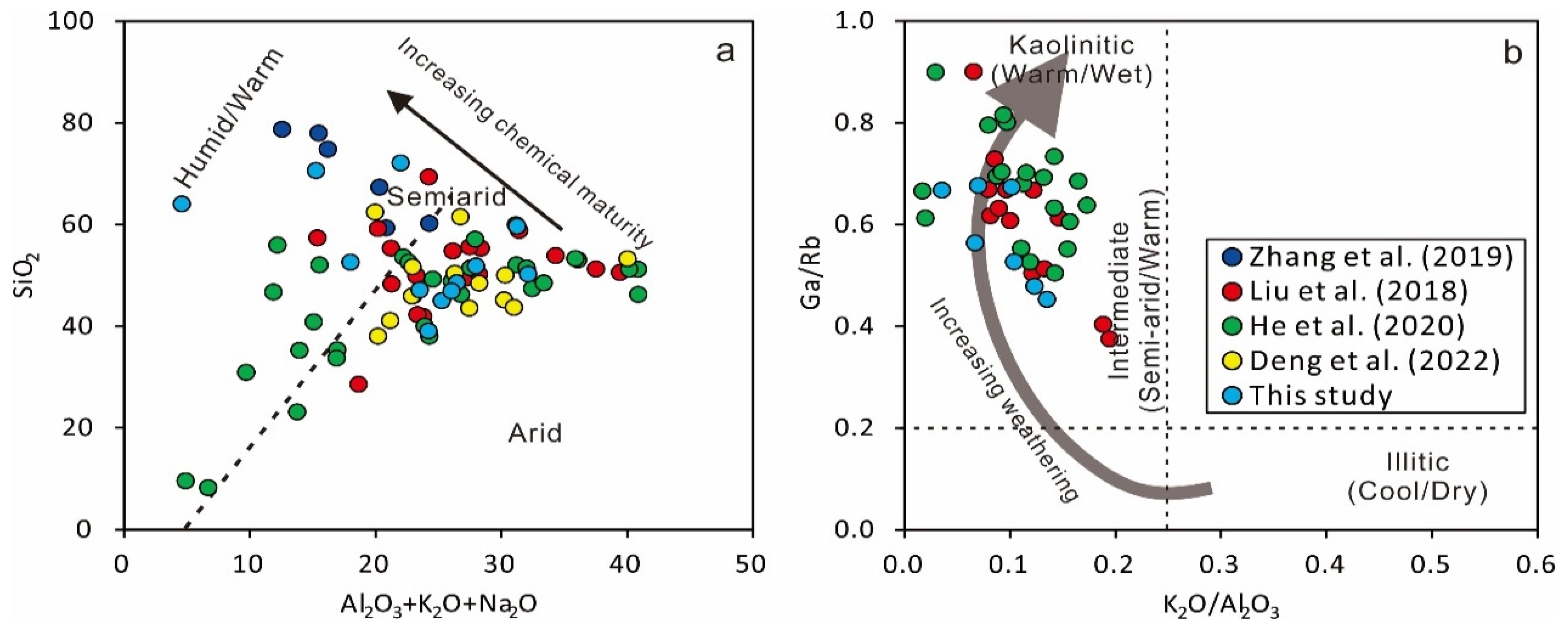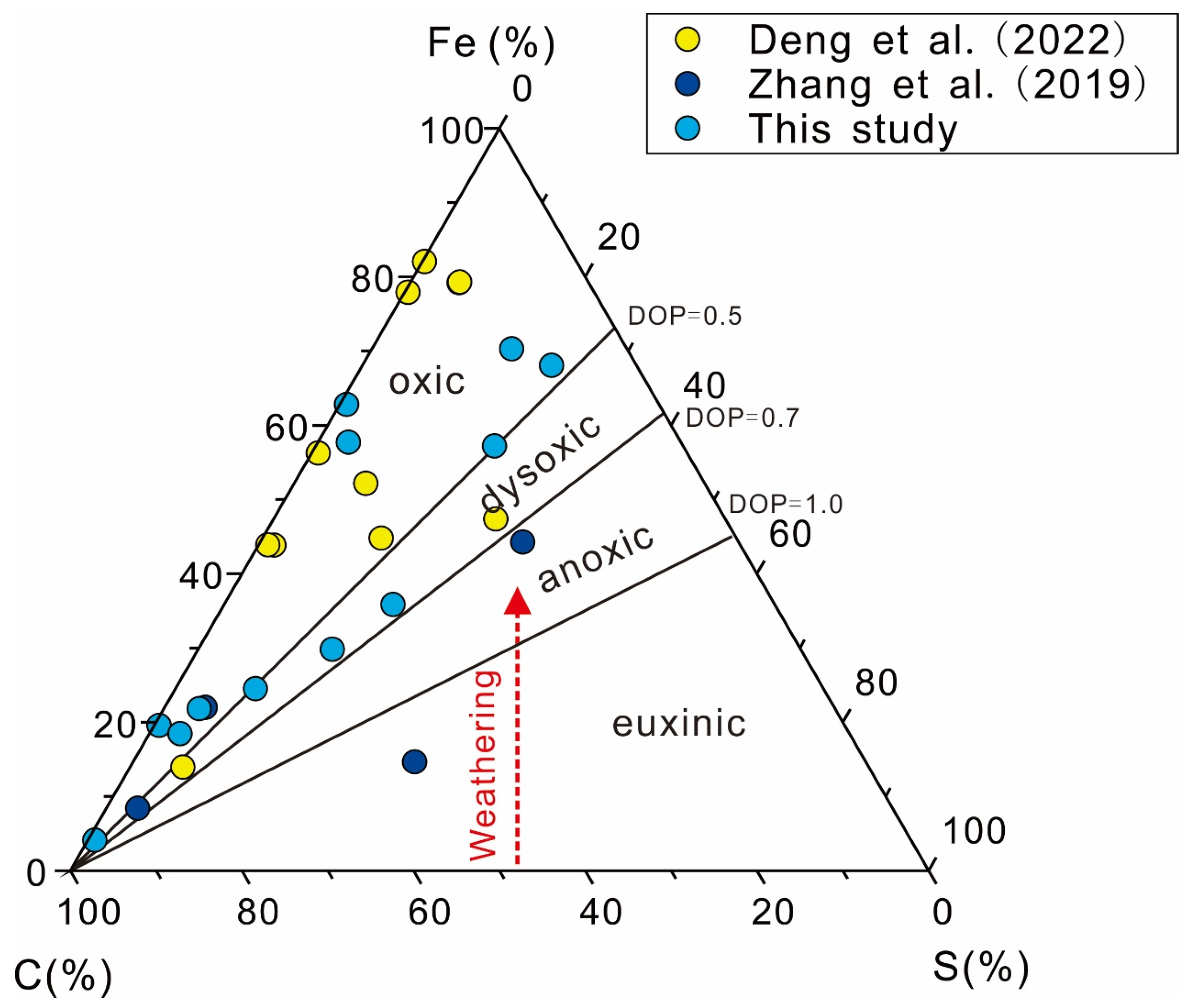Permian Longtan Shale in Guizhou, China: From Mineralogy and Geochemistry to Paleoenvironments
Abstract
1. Introduction
2. Geological Background
3. Samples and Methods
3.1. Petrology
3.2. The X-Ray Diffraction
3.3. X-Ray Fluorescence
3.4. Inductively Coupled Plasma Mass Spectrometry
4. Results
4.1. Petrology
4.2. Mineralogy
4.3. Major Elements
4.4. Trace and Rare Earth Elements
5. Discussion
5.1. Provenance and Tectonic Setting
5.2. Paleoclimate and Paleosalinity
5.3. Redox Conditions
5.4. Depositional Mode and Organic Matter Enrichment
6. Conclusions
- (1)
- The Longtan shale in the study area had a mixed source of materials with relatively larger proportions of basalt and andesite during its deposition. Organic matter in the Longtan shale was derived from both higher land plants and aquatic organisms, with the former accounts for the majority.
- (2)
- Semiarid to humid and warm climates were revealed during the periods of late Permian in the Guizhou Province, corresponding to an overall intensive weathering based on CIA, MIA, and other inorganic geochemical proxies. The Longtan shale was deposited in a brackish-to-marine water environment.
- (3)
- The redox condition during the deposition of the Longtan shale has unraveled using C-S-Fe, Co/Ni, V/Cr, U/Th, and V/(V + Ni), as well as the enrichment factors of U and Mo, which has also been compared to several modern marine environments. A variable redox condition, generally oxic-to-dysoxic, was reconstructed.
- (4)
- The paleoenvironments during the deposition of the Longtan shale in southwestern Guizhou province have been reconstructed based on this study and the results from previous works. Alternating of two stages, from sea level rise to down and from sea level down to rise, coupled with changes in climate, water salinity, and redox condition jointly controlled the formation of the Longtan shale.
Author Contributions
Funding
Data Availability Statement
Conflicts of Interest
References
- Eia. Technically Recoverable Shale Oil and Shale Gas Resources: An Assessment of 137 Shale Formations in 41Countries Outside the United States; U.S. Department of Energy: Washington, DC, USA, 2013.
- Mead, I. International Energy Outlook; US Energy Information Administration: Washington, DC, USA, 2017.
- Nie, H.K.; Tang, X.; Bian, R.K. Controlling factors for shale gas accumulation and prediction of potential development area in shale gas reservoir of South China. Acta Pet. Sin. 2009, 30, 484. [Google Scholar]
- Zhang, Q.; Littke, R.; Zieger, L.; Shabani, M.; Tang, X.; Zhang, J.C. Ediacaran, cambrian, ordovician, silurian and permian shales of the upper Yangtze platform, south China: Deposition, thermal maturity and shale gas potential. Int. J. Coal Geol. 2019, 216, 103281. [Google Scholar] [CrossRef]
- Zhang, Q.; Grohmann, S.; Xu, X.C.; Littke, R. Depositional environment and thermal maturity of the coal-bearing Longtan Shale in Southwest Guizhou, China: Implications for shale gas resource potential. Int. J. Coal Geol. 2020, 231, 103607. [Google Scholar] [CrossRef]
- Zheng, D.; Pang, X.; Luo, B.; Chen, D.; Pang, B.; Li, H.; Yu, R.; Guo, F.; Li, W. Geochemical characteristics, genetic types, and source of natural gas in the Sinian Dengying Formation, Sichuan Basin, China. J. Pet. Sci. Eng. 2021, 199, 108341. [Google Scholar] [CrossRef]
- Huang, J.L.; Zou, C.N.; Li, J.Z.; Dong, D.Z.; Wang, S.; Wang, S.Q.; Cheng, K.M. Shale gas generation and potential of the lower Cambrian Qiongzhusi formation in the southern Sichuan Basin, China. Pet. Explor. Dev. 2012, 39, 75–81. [Google Scholar] [CrossRef]
- Wu, Y.; Fan, T.L.; Jiang, S.; Yang, X.Q. Lithofacies and sedimentary sequence of the lower Cambrian Niutitang shale in the upper Yangtze platform, South China. J. Nat. Gas Sci. Eng. 2017, 43, 124–136. [Google Scholar] [CrossRef]
- He, Z.; Hu, Z.; Nie, H.; Li, S.; Xu, J. Characterization of shale gas enrichment in the Wufeng Formation–Longmaxi Formation in the Sichuan Basin of China and evaluation of its geological construction–transformation evolution sequence. J. Nat. Gas Geosci. 2017, 2, 1–10. [Google Scholar] [CrossRef]
- Zhang, Q.; Jin, Z.; Deng, E.; Xu, Z.; Zhu, R.; Liu, Q.; Yan, Z.; Hu, K.; Zheng, T.; Hu, Z. Accumulation and maturation of organic matter in shales: The coal-bearing Permian Longtan Formation at Tucheng Syncline, Southwestern Guizhou, China. Appl. Geochem. 2025, 180, 106257. [Google Scholar] [CrossRef]
- Zhang, J.; Li, X.; Wei, Q.; Gao, W.; Liang, W.; Wang, Z.; Wang, F. Quantitative characterization of pore-fracture system of organic-rich marine-continental shale reservoirs: A case study of the Upper Permian Longtan Formation, Southern Sichuan Basin, China. Fuel 2017, 200, 272–281. [Google Scholar] [CrossRef]
- Zhang, J.; Li, X.; Zhang, X.; Zhang, M.; Cong, G.; Zhang, G.; Wang, F. Geochemical and geological characterization of marine–continental transitional shales from Longtan Formation in Yangtze area, South China. Mar. Pet. Geol. 2018, 96, 1–15. [Google Scholar] [CrossRef]
- Luo, W.; Hou, M.; Liu, X.; Huang, S.; Chao, H.; Zhang, R.; Deng, X. Geological and geochemical characteristics of marine-continental transitional shale from the Upper Permian Longtan formation, Northwestern Guizhou, China. Mar. Petrol. Geol. 2018, 89, 58–67. [Google Scholar] [CrossRef]
- Deng, E.; Zhang, Q.; Jin, Z.; Zhu, R.; Yan, Z.; Jiang, B.; Littke, R. Non-overmature equivalents confirmed a high initial hydrocarbon generation potential of the Permian Longtan Shale in southern China. Int. J. Coal Geol. 2022, 259, 104043. [Google Scholar] [CrossRef]
- Zheng, T.; Zhang, Q.; Deng, E. Applications of low molecular weight polycyclic aromatic hydrocarbons (PAHs) and diamondoids ratios/indices on the maturity assessment of coal-bearing source rock: Insight from mature to overmature Longtan Shale. Int. J. Coal Geol. 2023, 269, 104209. [Google Scholar] [CrossRef]
- Peters, K.E.; Walters, C.C.; Moldowan, J.M. The Biomarker Guide; Cambridge University Press: Cambridge, UK, 2005; p. 1155. [Google Scholar]
- Dou, X.; Jiang, B.; Qin, Y.; Wang, W.; Chen, W. Structure evolution in west ofguizhou area and control to seam in late permian. Coal Sci. Technol. 2012, 40, 109–114. [Google Scholar]
- Zhang, J.; Ren, D.; Zhu, Y.; Chou, C.; Zeng, R.; Zheng, B. Mineral matter and potentially hazardous trace elements in coals from Qianxi Fault depression area in southwestern Guizhou, China. Int. J. Coal Geol. 2004, 57, 49–61. [Google Scholar] [CrossRef]
- Li, Y.; Zhang, T.; Ellis, G.; Shao, D. Depositional environment and organic matter accumulation of Upper Ordovician–Lower Silurian marine shale in the Upper Yangtze Platform, South China. Palaeogeogr. Palaeoclimatol. Palaeoecol. 2016, 466, 252–264. [Google Scholar] [CrossRef]
- Li, M.; Jiang, B.; Liu, J.; Zhu, P.; Chen, G. Geological models and structure controls of tectonically deformed coal in Tucheng syncline, western Guizhou Province. J. China Coal Soc. 2018, 43, 1565–1571. [Google Scholar]
- Xiong, M.; Qin, Y.; Yi, T. Sedimentary patterns and structural controls of Late Permian coal-bearing strata in Guizhou, China. J. China Univ. Min. Technol. 2006, 35, 778. [Google Scholar]
- Ma, X.; Guo, S.; Shi, D.; Zhou, Z.; Liu, G. Investigation of pore structure and fractal characteristics of marine-continental transitional shales from Longtan Formation using MICP, gas adsorption, and NMR (guizhou, China). Mar. Petrol. Geol. 2019, 107, 555–571. [Google Scholar] [CrossRef]
- Dai, S.; Ren, D.; Tang, Y.; Yue, M.; Hao, L. Concentration and distribution of elements in late Permian coals from western Guizhou Province, China. Int. J. Coal Geol. 2005, 61, 119–137. [Google Scholar] [CrossRef]
- Liu, S.; Wu, C.; Li, T.; Wang, H. Multiple geochemical proxies controlling the organic matter accumulation of the marine-continental transitional shale: A case study of the Upper Permian Longtan Formation, western Guizhou, China. J. Nat. Gas Sci. Eng. 2018, 56, 152–165. [Google Scholar] [CrossRef]
- Liu, B.; Song, Y.; Zhu, K.; Su, P.; Ye, X.; Zhao, W. Mineralogy and element geochemistry of salinized lacustrine organic-rich shale in the Middle Permian Santanghu Basin: Implications for paleoenvironment, provenance, tectonic setting and shale oil potential. Mar. Pet. Geol. 2020, 120, 104569. [Google Scholar] [CrossRef]
- He, Q.; Dong, T.; He, S.; Zhai, G.; Guo, X.; Hou, Y.; Yang, R.; Han, Y. Sedimentological and geochemical characterization of the Upper Permian transitional facies of the Longtan Formation, northern Guizhou Province, southwest China: Insights into paleo-environmental conditions and organic matter accumulation mechanisms. Mar. Pet. Geol. 2020, 118, 104446. [Google Scholar] [CrossRef]
- Ghosh, S.; Sarkar, S. Geochemistry of Permo-Triassic mudstone of the Satpura Gondwana basin, central India: Clues for provenance. Chem. Geol. 2010, 277, 78–100. [Google Scholar] [CrossRef]
- McLennan, S.M.; Hemming, S.; McDaniel, D.K.; Hanson, G.N. Geochemical approaches to sedimentation, provenance, and tectonics. Spec. Pap.—Geol. Soc. Am. 1993, 284, 21–40. [Google Scholar]
- Qiao, J.; Luo, Q.; Zhang, K.; Zhang, G.; Duan, J.; Wang, D.; Yu, H.; Wang, S.; Qu, Y.; Kopaevich, L. Geochemistry and organic petrography of the Middle Permian Lucaogou alkaline lacustrine oil shale in the southern Junggar Basin, China: Implications for formation conditions and organic matter accumulation. Int. J. Coal Geol. 2023, 268, 104198. [Google Scholar] [CrossRef]
- Nesbitt, H.W.; Young, G.M. Early Proterozoic climates and plate motions inferred from major element chemistry of lutites. Nature 1982, 199, 715–717. [Google Scholar] [CrossRef]
- Fedo, C.M.; Nesbitt, H.W.; Young, G.M. Unraveling the effects of potassium metasomatism in sedimentary rocks and paleosols, with implications for paleoweathering conditions and provenance. Geology 1995, 23, 921–924. [Google Scholar] [CrossRef]
- Nesbitt, H.W.; Young, G.M. Petrogenesis of sediments in the absence of chemical weathering: Effects of abrasion and sorting on bulk composition and mineralogy. Sedimentology 1996, 43, 341–358. [Google Scholar] [CrossRef]
- Makeen, Y.M.; Hakimi, M.H.; Abdullah, W.H. The origin, type and preservation of organic matter of the Barremian–Aptian organic-rich shales in the Muglad Basin, Southern Sudan, and their relation to paleoenvironmental and paleoclimate conditions. Mar. Pet. Geol. 2015, 65, 187–197. [Google Scholar] [CrossRef]
- Fan, B. Geochemical characteristics and paleoenvironment of organic-rich Triassic shale in the central Ordos Basin. Nat. Resour. Res. 2022, 31, 1739–1757. [Google Scholar] [CrossRef]
- Shi, L.; Yu, X.; Yuan, J.; Xu, J.; Yang, L.; Sun, L.; Li, G.; Zhang, Y.; Chen, D.; Li, G. Sedimentary Paleoenvironment and Organic Matter Enrichment of the Ying 4 Member in the Southern Shuangcheng Area, Songliao Basin. Minerals 2024, 14, 1152. [Google Scholar] [CrossRef]
- Wei, W.; Algeo, T.J. Elemental proxies for paleosalinity analysis of ancient shales and mudrocks. Geochim. Cosmochim. Acta 2020, 287, 341–366. [Google Scholar] [CrossRef]
- Sajid, Z.; Ismail, M.S.; Zakariah, M.N.A.; Tsegab, H.; Gámez Vintaned, J.A.; Hanif, T.; Ahmed, N. Impact of paleosalinity, paleoredox, paleoproductivity/preservation on the organic matter enrichment in black shales from triassic turbidites of semanggol basin, peninsular malaysia. Minerals 2020, 10, 915. [Google Scholar] [CrossRef]
- Qiao, J.; Baniasad, A.Z.; Zieger, L.; Zhang, C.; Luo, Q.; Littke, R. Paleo-depositional environment, origin and characteristics of organic matter of the Triassic Chang 7 Member of the Yanchang Formation throughout the mid-western part of the Ordos Basin, China. Int. J. Coal Geol. 2021, 237, 103636. [Google Scholar] [CrossRef]
- Wu, Z.; Littke, R.; Baniasad, A.; Yang, Z.; Tang, Z.; Grohmann, S. Geochemistry and petrology of petroleum source rocks in the Upper Cretaceous Qingshankou Formation, Songliao Basin, NE China. Int. J. Coal Geol. 2023, 270, 104222. [Google Scholar] [CrossRef]
- Uffmann, A.K.; Littke, R.; Rippen, D. Mineralogy and geochemistry of Mississippian and Lower Pennsylvanian black shales at the northern margin of the Variscan Mountain Belt (Germany and Belgium). Int. J. Coal Geol. 2012, 103, 92–108. [Google Scholar] [CrossRef]
- Emmings, J.F.; Poulton, S.W.; Vane, C.H.; Davies, S.J.; Jenkin, G.R.; Stephenson, M.H.; Lamb, A.L.; Moss-Hayes, V. A Mississippian black shale record of redox oscillation in the Craven Basin, UK. Palaeogeogr. Palaeoclimatol. Palaeoecol. 2020, 538, 109423. [Google Scholar] [CrossRef]
- Wang, Y.; Zhang, H.; Chen, H.; Zhu, Y.; Yang, J.; Zhang, Y.; Wang, Z. The sedimentary environment and main controlling factors of organic matter enrichment of Carboniferous-Permian marine-continental transitional shale in Kaiping syncline. Pet. Sci. Technol. 2024, 43, 2186–2206. [Google Scholar] [CrossRef]
- Yano, M.; Yasukawa, K.; Nakamura, K.; Ikehara, M.; Kato, Y. Geochemical features of redox-sensitive trace metals in sediments under oxygen-depleted marine environments. Minerals 2020, 10, 1021. [Google Scholar] [CrossRef]
- Chow, N.; Wendte, J.; Stasiuk, L. Productivity versus preservation controls on two organic-rich carbonate facies in the Devonian of Alberta: Sedimentological and organic petrological evidence. Bull. Can. Pet. Geol. 1995, 43, 433–460. [Google Scholar]
- Lu, Y.; Jiang, S.; Lu, Y.; Xu, S.; Shu, Y.; Wang, Y. Productivity or preservation? The factors controlling the organic matter accumulation in the late Katian through Hirnantian Wufeng organic-rich shale, South China. Mar. Pet. Geol. 2019, 109, 22–35. [Google Scholar] [CrossRef]
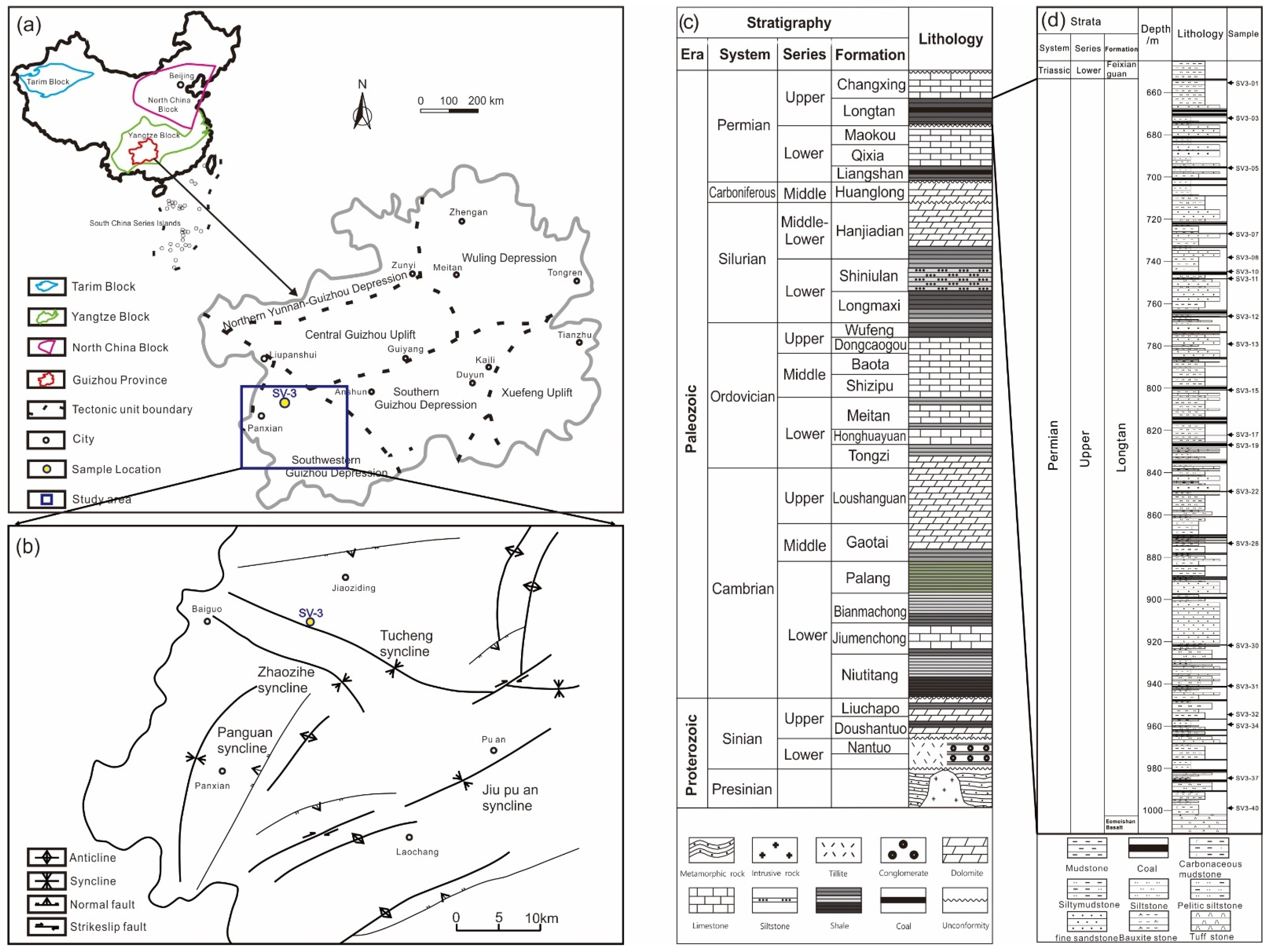

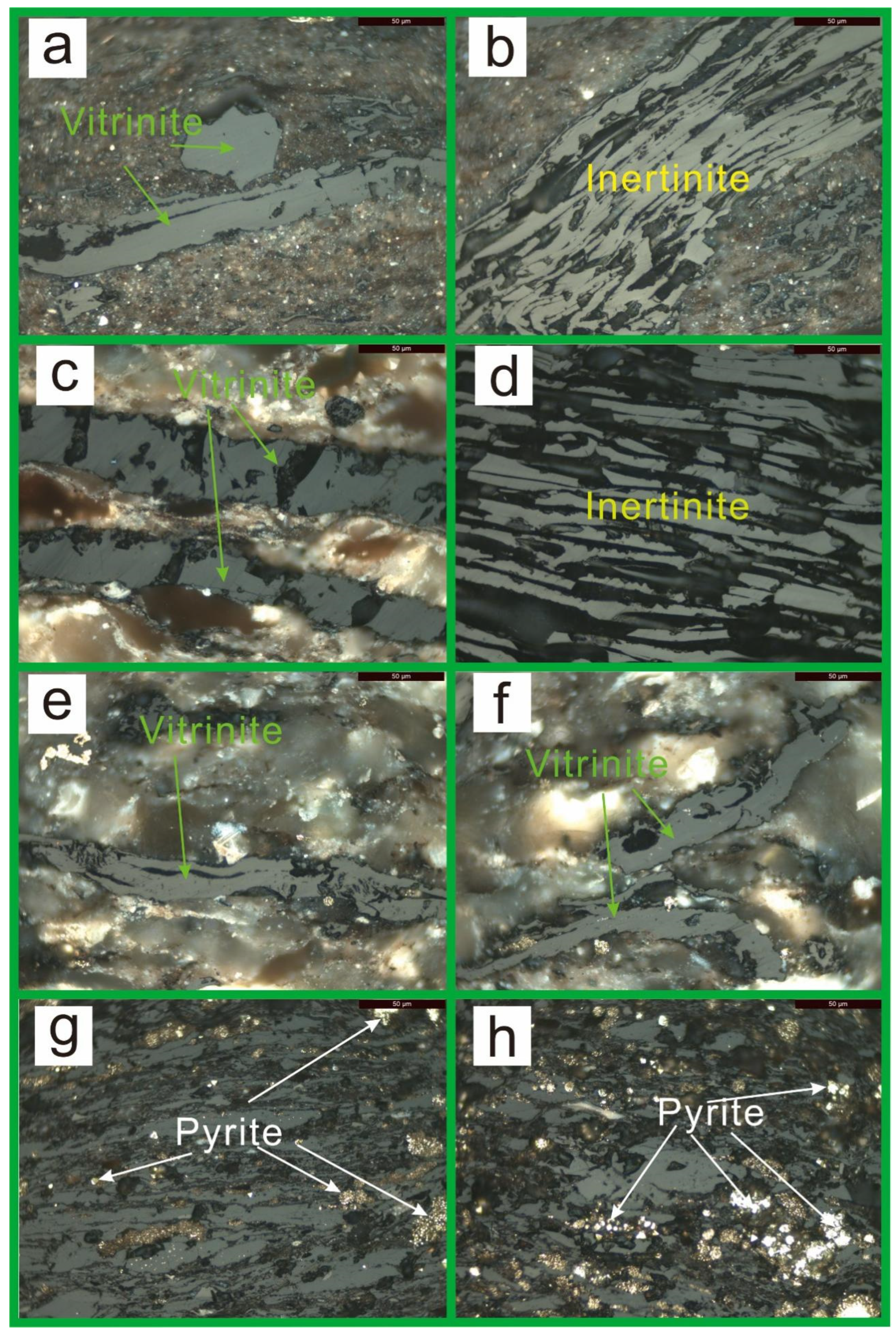
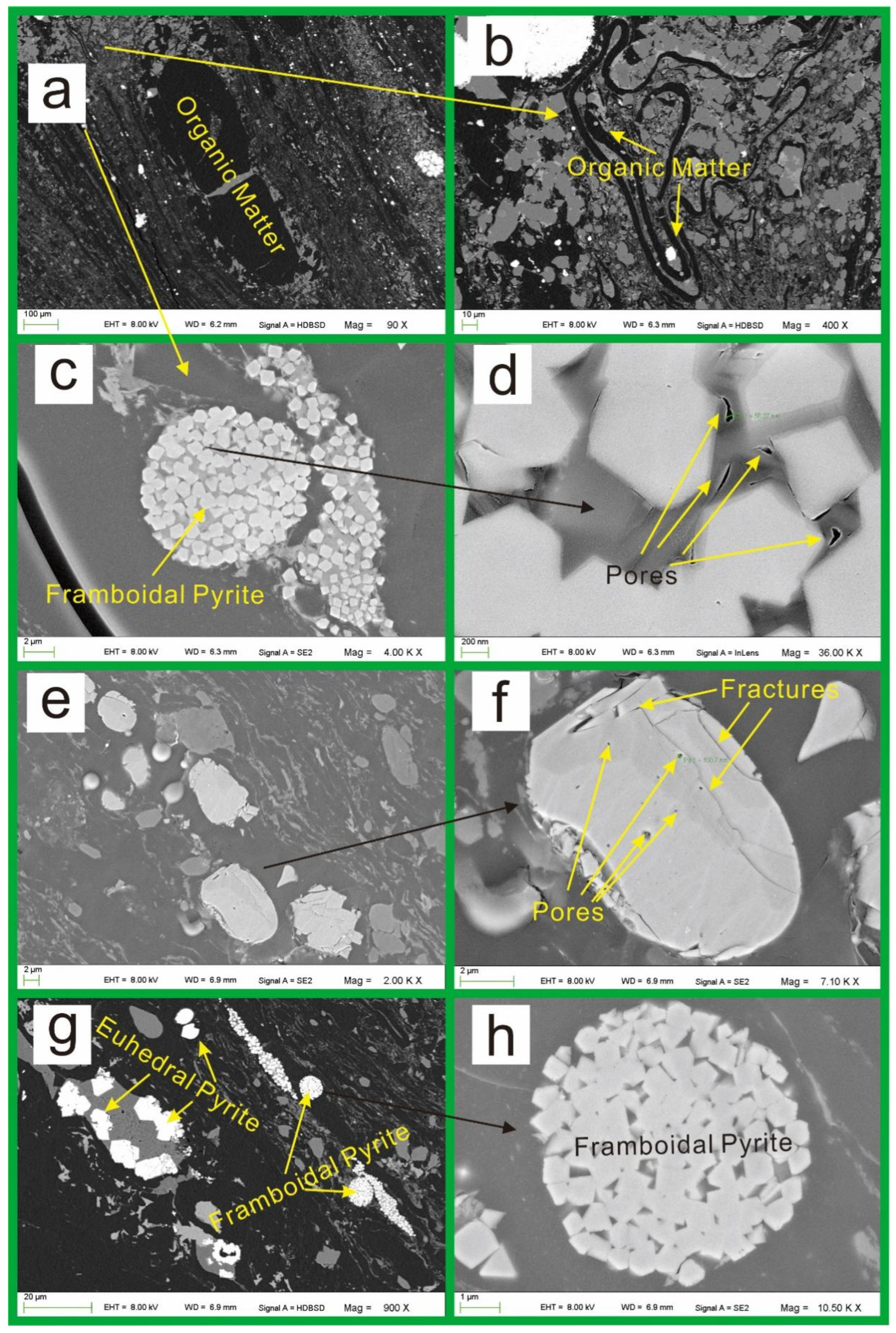
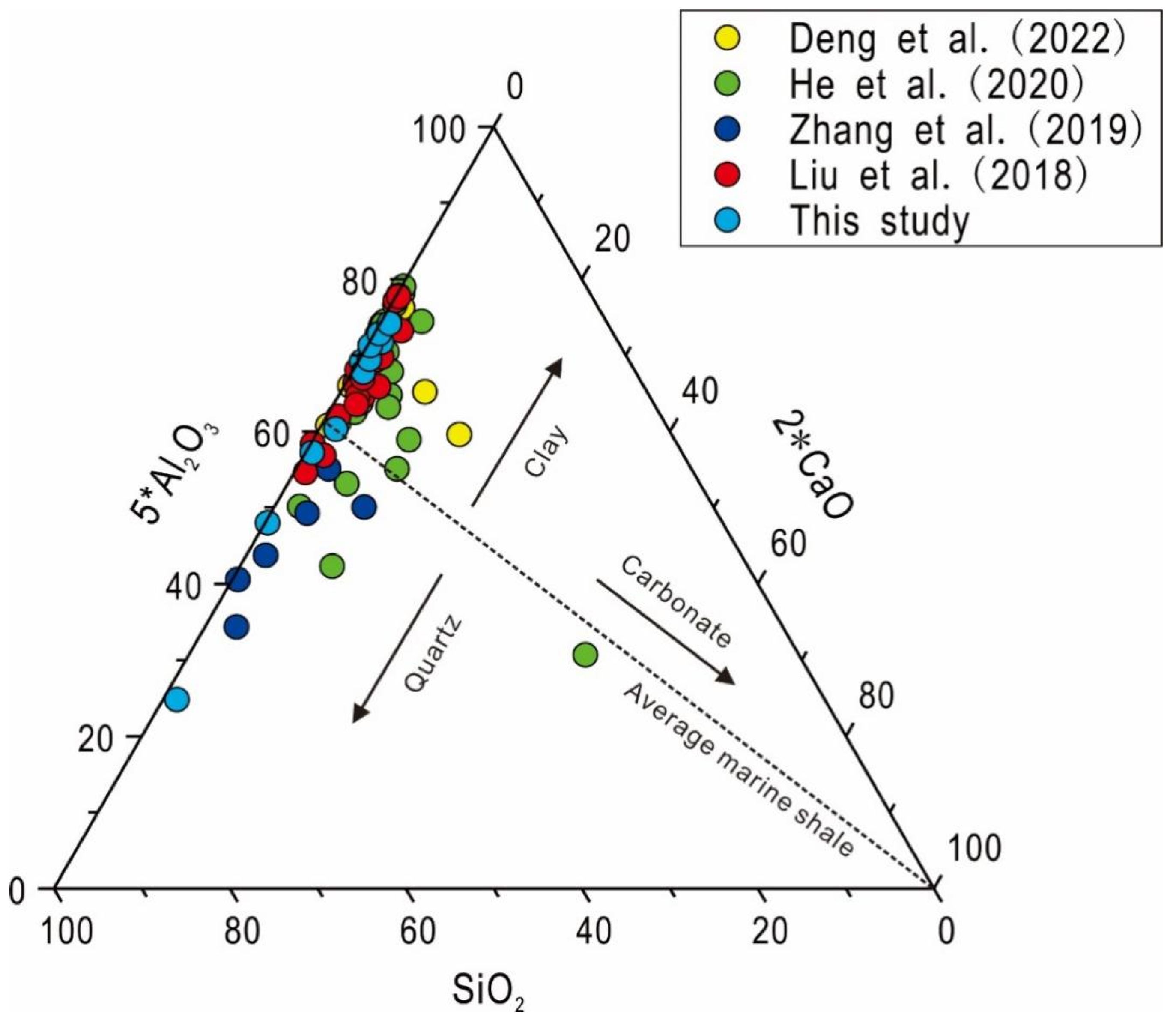


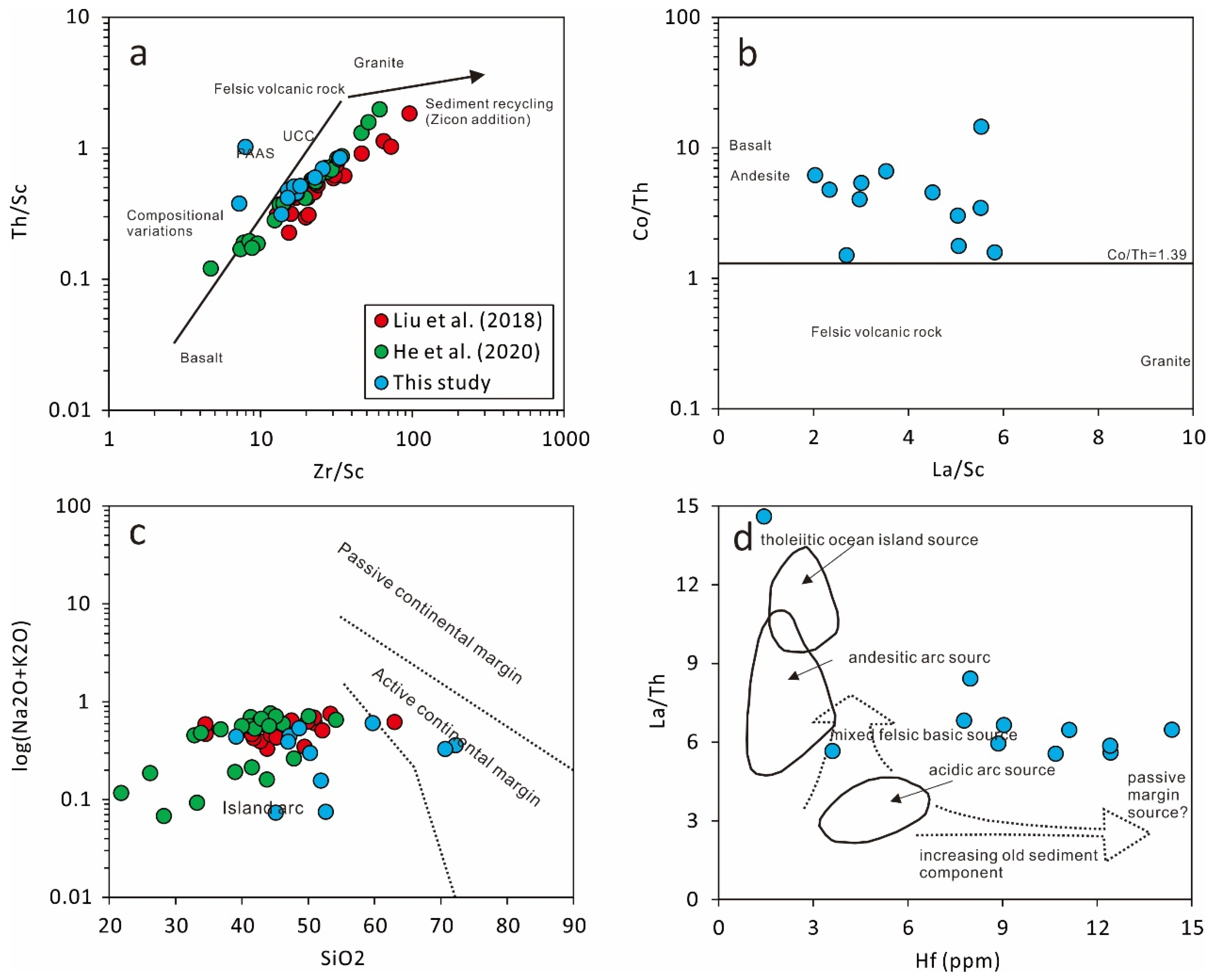
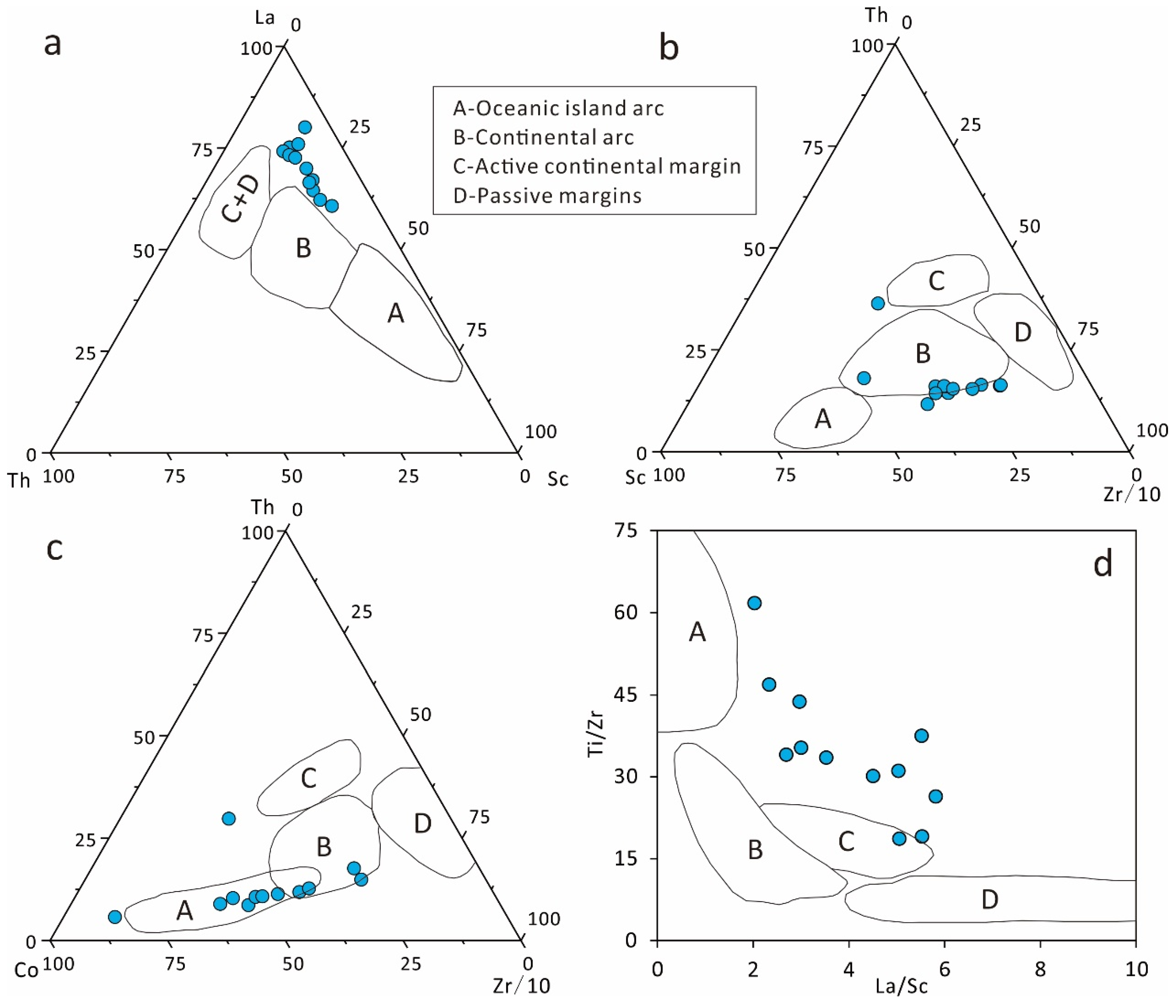

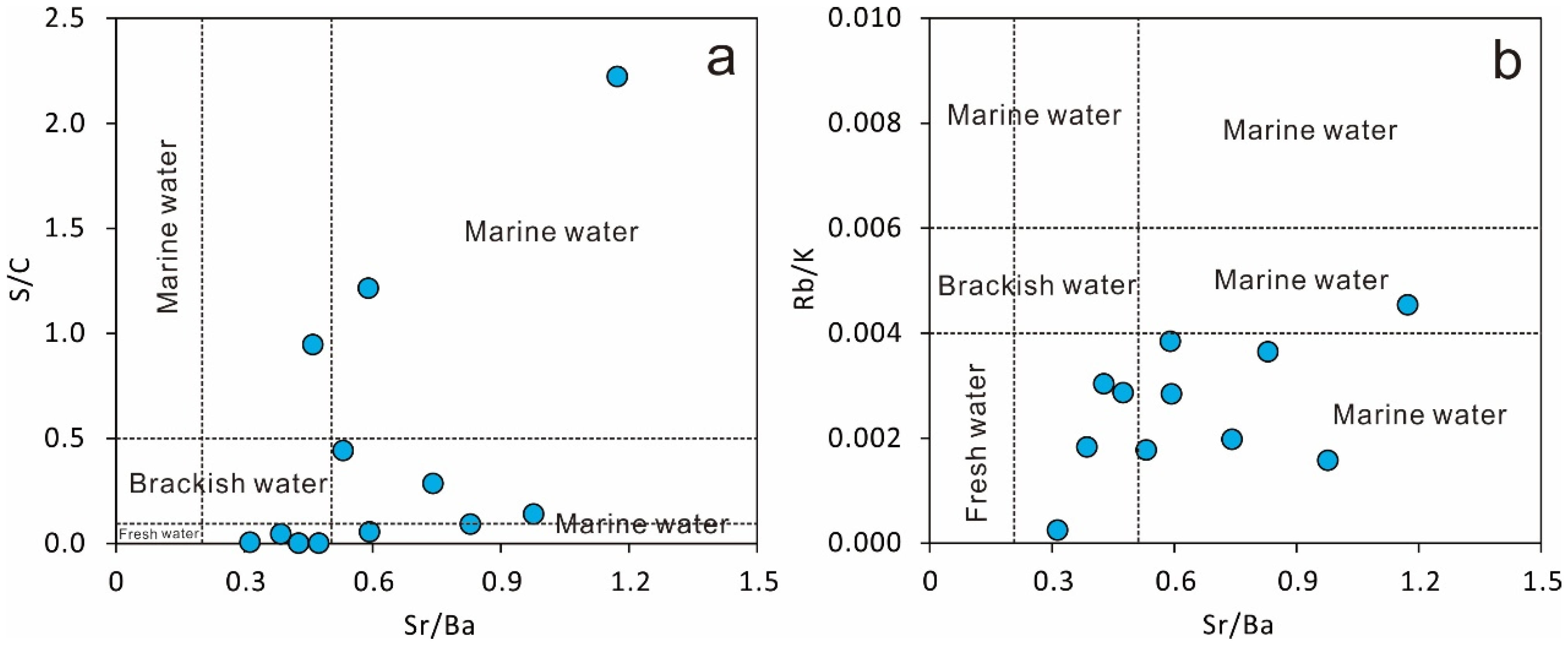

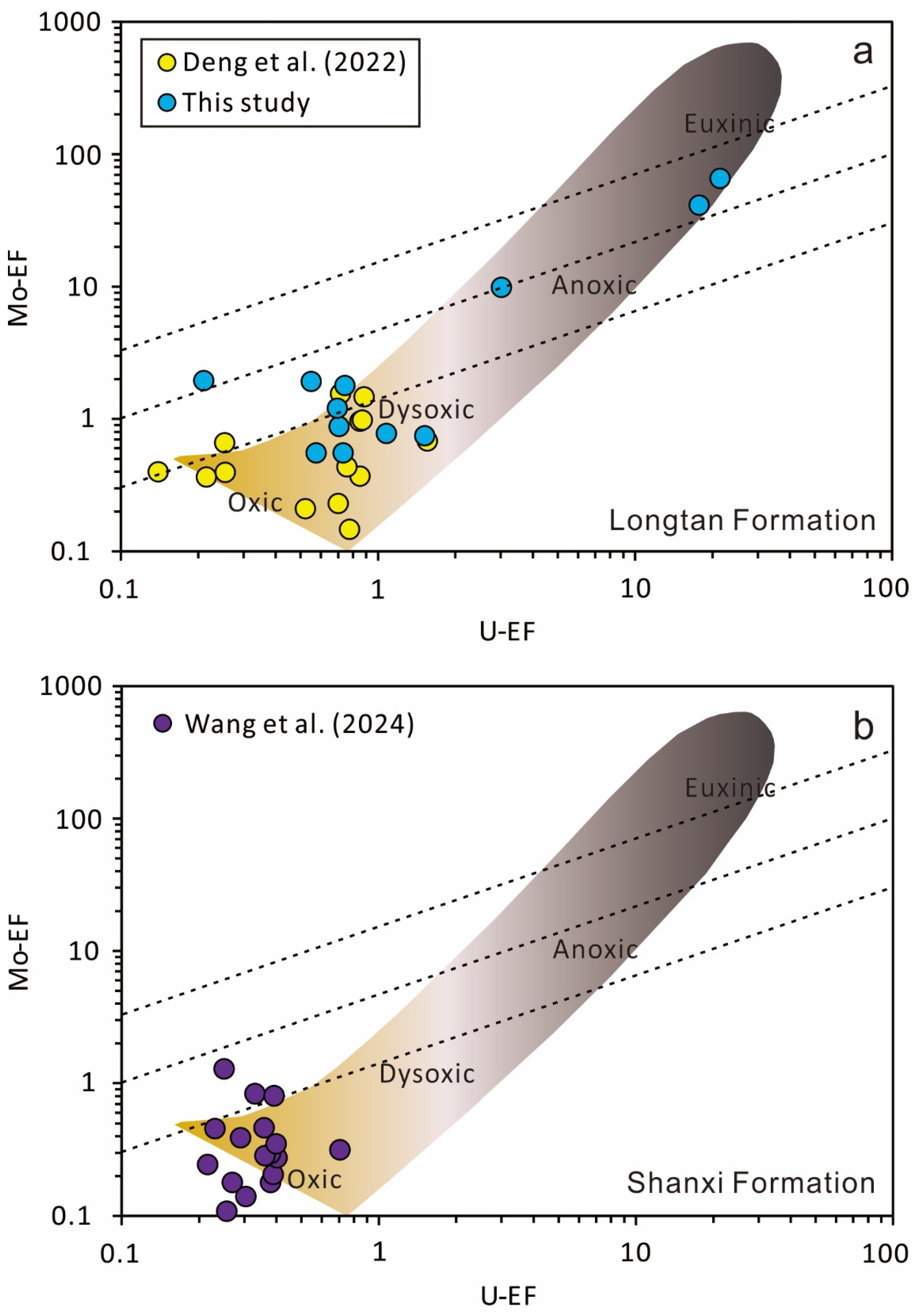
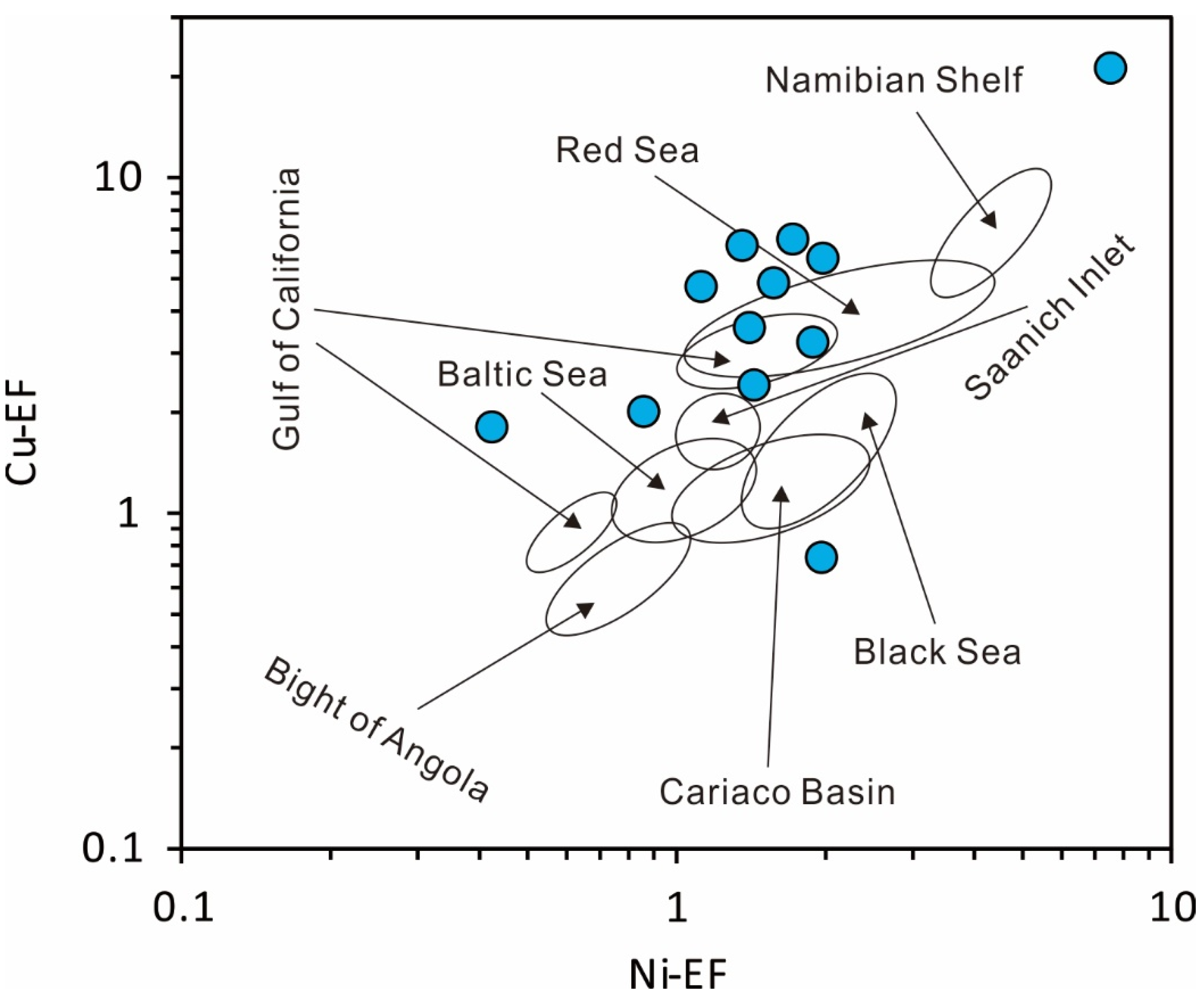
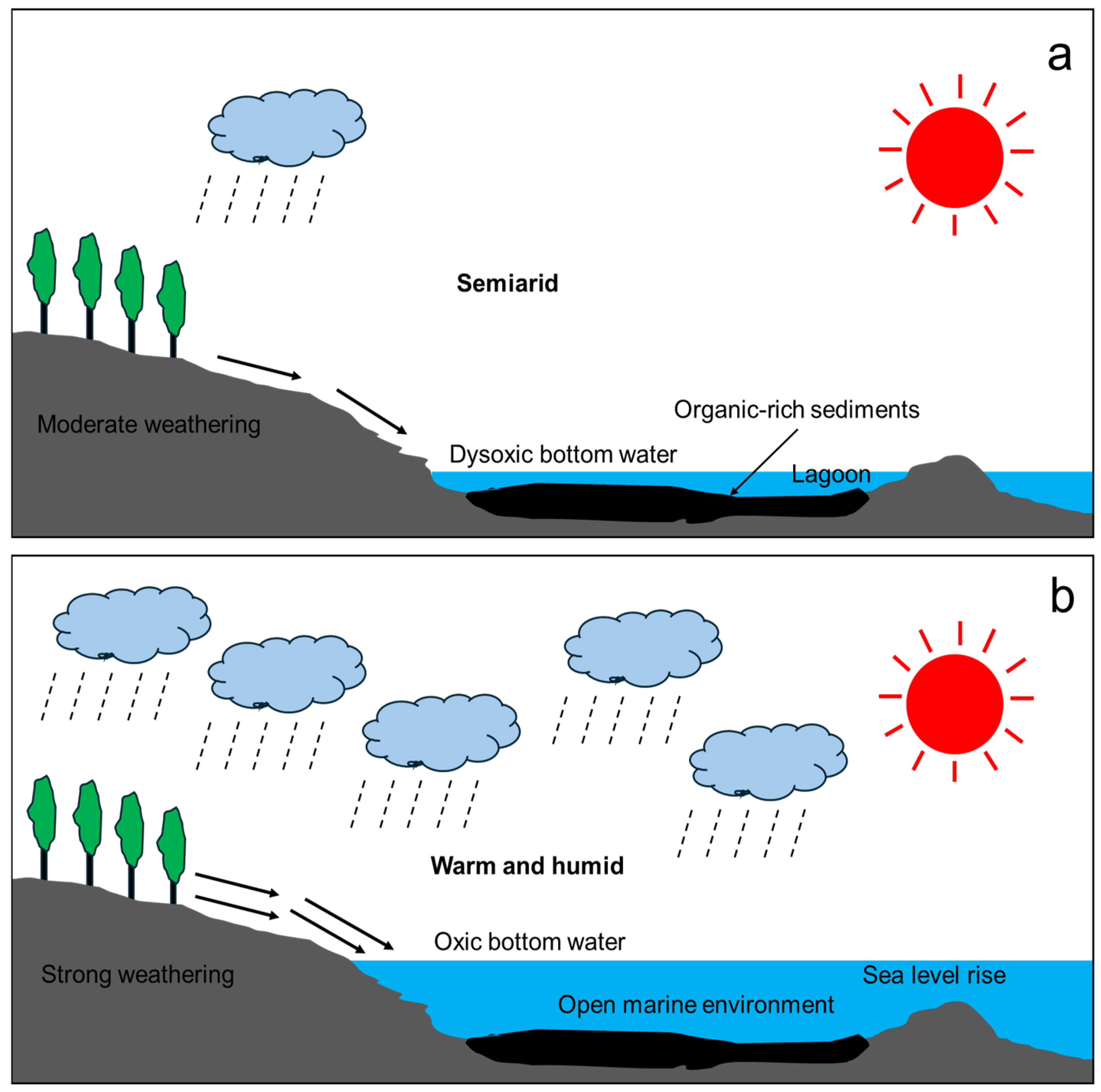
| Sample No. | Bulk Mineralogical Composition (wt.%) | Clay Mineralogical Composition (wt.%) | ||||||||
|---|---|---|---|---|---|---|---|---|---|---|
| Qua | Fel | Car | Pyr | Clay | Others | I | K | C | I/S | |
| SV3-01 | 22 | - | - | - | 69 | 9 | - | 47 | 53 | - |
| SV3-03 | 14 | - | - | - | 75 | 11 | 8 | 38 | 27 | 27 |
| SV3-05 | 18 | - | - | - | 77 | 5 | 6 | 32 | 23 | 39 |
| SV3-07 | 14 | 14 | - | 4 | 55 | 13 | 11 | 11 | 46 | 32 |
| SV3-08 | 19 | 8 | - | 6 | 61 | 6 | - | 19 | 81 | - |
| SV3-10 | 7 | - | - | 9 | 73 | 11 | 6 | 28 | 42 | 24 |
| SV3-11 | 14 | 14 | 4 | 4 | 58 | 6 | 19 | 16 | 27 | 38 |
| SV3-12 | 27 | - | 26 | - | 40 | 7 | 5 | 15 | 61 | 19 |
| SV3-13 | 17 | 3 | 9 | - | 66 | 5 | 8 | 20 | 30 | 42 |
| SV3-15 | 12 | - | - | - | 83 | 5 | - | 59 | 41 | - |
| SV3-17 | 51 | 3 | - | - | 43 | 3 | - | 77 | 23 | - |
| SV3-19 | 7 | - | - | - | 88 | 5 | - | 78 | 18 | 4 |
| SV3-22 | 86 | - | - | - | 14 | - | - | 100 | - | - |
| SV3-26 | 21 | - | - | 8 | 60 | 11 | 6 | 39 | 22 | 33 |
| SV3-30 | 66 | - | - | 3 | 31 | - | - | 20 | 80 | - |
| SV3-31 | 17 | - | 7 | 23 | 53 | - | - | 52 | 48 | - |
| SV3-32 | 15 | 12 | 4 | - | 63 | 6 | 3 | 17 | 61 | 19 |
| SV3-34 | 31 | - | - | 16 | 48 | 5 | - | 55 | 45 | - |
| SV3-37 | 13 | - | - | - | 82 | 5 | - | 56 | 44 | - |
| SV3-40 | 23 | - | - | 4 | 64 | 9 | - | 45 | 55 | - |
| Sample No. | SiO2 | Al2O3 | MgO | Na2O | K2O | P2O5 | TiO2 | CaO | Fe2O3 | MnO |
|---|---|---|---|---|---|---|---|---|---|---|
| SV3-01 | 45.06 | 24.06 | 2.50 | 0.17 | 1.01 | 0.46 | 4.97 | 1.18 | 20.52 | 0.07 |
| SV3-05 | 59.70 | 27.18 | 1.64 | 0.71 | 3.35 | 0.10 | 3.58 | 0.41 | 3.33 | 0.01 |
| SV3-08 | 47.15 | 20.66 | 3.15 | 1.38 | 1.44 | 0.35 | 5.25 | 1.00 | 19.55 | 0.08 |
| SV3-13 | 48.62 | 22.98 | 2.37 | 1.09 | 2.38 | 0.34 | 3.63 | 0.95 | 16.77 | 0.88 |
| SV3-17 | 72.18 | 19.67 | 0.63 | 0.99 | 1.31 | 0.26 | 3.07 | 0.67 | 1.21 | 0.01 |
| SV3-22 | 46.94 | 23.56 | 1.18 | 0.83 | 1.64 | 0.10 | 4.28 | 0.28 | 21.17 | 0.04 |
| SV3-26 | 64.09 | 4.32 | 0.67 | 0.11 | 0.15 | 0.04 | 0.30 | 0.69 | 29.59 | 0.04 |
| SV3-30 | 70.62 | 13.10 | 1.52 | 0.37 | 1.77 | 0.07 | 0.88 | 0.21 | 11.44 | 0.02 |
| SV3-31 | 39.09 | 21.40 | 0.76 | 0.61 | 2.17 | 0.13 | 3.03 | 0.44 | 32.20 | 0.16 |
| SV3-34 | 52.62 | 16.79 | 0.72 | 0.47 | 0.72 | 0.09 | 2.12 | 1.33 | 25.07 | 0.08 |
| SV3-37 | 50.26 | 30.10 | 1.25 | 0.78 | 1.23 | 0.61 | 4.39 | 1.09 | 10.17 | 0.13 |
| SV3-40 | 51.87 | 26.53 | 0.47 | 0.55 | 0.89 | 0.12 | 3.22 | 0.53 | 15.78 | 0.04 |
| Sample No. | Li | Be | V | Cr | Co | Ni | Cu | Zn | Ga | Rb | Sr | Zr | Nb | Mo | Cs | Ba | Hf | Ta | W | Tl | Pb | Sn | U | Th |
|---|---|---|---|---|---|---|---|---|---|---|---|---|---|---|---|---|---|---|---|---|---|---|---|---|
| SV3-01 | 51.60 | 3.45 | 338.59 | 123.63 | 61.82 | 137.53 | 228.73 | 181.43 | 39.25 | 38.13 | 254.92 | 574.99 | 73.33 | 2.08 | 2.05 | 217.49 | 14.36 | 3.57 | 1.83 | 0.29 | 20.44 | 4.72 | 3.13 | 15.29 |
| SV3-05 | 37.56 | 3.36 | 377.65 | 179.01 | 23.97 | 106.62 | 281.90 | 54.09 | 37.87 | 79.12 | 560.92 | 501.82 | 61.30 | 1.49 | 2.95 | 946.77 | 12.42 | 3.38 | 1.68 | 0.17 | 11.64 | 4.70 | 3.67 | 15.88 |
| SV3-08 | 52.17 | 2.38 | 354.67 | 113.61 | 62.44 | 93.88 | 165.73 | 182.02 | 31.19 | 46.10 | 417.11 | 440.79 | 60.90 | 1.59 | 1.60 | 707.15 | 11.10 | 3.12 | 1.06 | 0.14 | 14.82 | 4.17 | 4.09 | 10.07 |
| SV3-13 | 28.91 | 4.06 | 282.92 | 169.03 | 86.00 | 125.22 | 122.77 | 110.92 | 31.68 | 60.10 | 414.59 | 517.44 | 71.47 | 4.06 | 1.94 | 971.80 | 12.40 | 3.75 | 1.55 | 0.18 | 19.68 | 4.41 | 3.14 | 15.90 |
| SV3-17 | 3.98 | 1.70 | 252.86 | 71.79 | 31.13 | 97.60 | 213.13 | 160.35 | 17.61 | 31.21 | 199.27 | 355.92 | 40.52 | 1.08 | 1.32 | 420.50 | 9.04 | 2.16 | 0.69 | 0.08 | 5.90 | 3.10 | 2.08 | 8.96 |
| SV3-22 | 22.15 | 0.39 | 78.78 | 57.59 | 45.66 | 133.71 | 28.75 | 21.04 | 4.86 | 3.42 | 37.20 | 59.88 | 5.17 | 4.54 | 0.23 | 118.82 | 1.43 | 0.31 | 0.24 | 4.86 | 37.56 | 0.76 | 0.91 | 3.14 |
| SV3-26 | 43.00 | 2.98 | 328.42 | 144.88 | 57.90 | 94.17 | 151.33 | 104.78 | 29.75 | 44.58 | 275.92 | 434.75 | 63.48 | 28.02 | 1.86 | 599.51 | 10.68 | 3.43 | 1.25 | 0.58 | 16.41 | 3.71 | 17.00 | 12.09 |
| SV3-30 | 78.66 | 1.22 | 107.17 | 48.14 | 25.28 | 54.37 | 52.22 | 20.12 | 12.21 | 26.95 | 86.53 | 123.74 | 18.66 | 0.97 | 1.68 | 224.63 | 3.61 | 1.17 | 1.11 | 0.08 | 20.79 | 2.42 | 3.66 | 15.96 |
| SV3-31 | 24.30 | 2.41 | 331.70 | 83.50 | 59.46 | 86.85 | 126.46 | 62.04 | 21.56 | 32.04 | 226.87 | 317.09 | 44.32 | 87.22 | 1.29 | 427.35 | 7.78 | 2.30 | 1.11 | 1.53 | 13.77 | 2.66 | 69.95 | 8.96 |
| SV3-34 | 19.39 | 1.84 | 115.76 | 49.93 | 17.34 | 41.67 | 55.71 | 76.02 | 15.74 | 11.81 | 141.08 | 384.67 | 55.68 | 16.42 | 0.79 | 190.43 | 8.86 | 2.72 | 0.92 | 1.09 | 12.15 | 3.34 | 9.34 | 9.78 |
| SV3-37 | 30.73 | 5.13 | 288.48 | 53.04 | 85.33 | 97.50 | 235.11 | 167.87 | 39.19 | 37.16 | 451.76 | 684.65 | 96.90 | 3.59 | 1.27 | 545.12 | 17.26 | 4.96 | 1.64 | 0.10 | 15.92 | 6.22 | 3.85 | 18.66 |
| SV3-40 | 59.64 | 3.54 | 261.17 | 37.93 | 25.77 | 32.49 | 79.16 | 59.52 | 17.97 | 11.65 | 168.65 | 324.50 | 45.70 | 5.05 | 0.48 | 172.71 | 7.97 | 2.42 | 0.87 | 0.20 | 5.36 | 2.48 | 2.68 | 8.50 |
| Sample No. | Sc | Y | La | Ce | Pr | Nd | Sm | Eu | Gd | Tb | Dy | Ho | Er | Tm | Yb | Lu |
|---|---|---|---|---|---|---|---|---|---|---|---|---|---|---|---|---|
| SV3-01 | 33.42 | 58.95 | 99.21 | 196.65 | 25.04 | 97.46 | 19.19 | 5.36 | 17.21 | 2.39 | 11.74 | 2.19 | 5.67 | 0.72 | 4.65 | 0.66 |
| SV3-05 | 33.08 | 50.68 | 89.09 | 172.24 | 21.86 | 82.44 | 14.37 | 3.34 | 11.94 | 1.89 | 10.35 | 2.05 | 5.40 | 0.67 | 4.45 | 0.63 |
| SV3-08 | 32.12 | 42.12 | 65.20 | 126.63 | 16.44 | 62.16 | 11.55 | 3.22 | 10.23 | 1.54 | 8.45 | 1.66 | 4.45 | 0.57 | 3.64 | 0.53 |
| SV3-13 | 31.09 | 54.24 | 93.34 | 181.10 | 22.00 | 79.93 | 12.78 | 2.75 | 9.81 | 1.68 | 9.80 | 2.09 | 5.89 | 0.77 | 5.06 | 0.74 |
| SV3-17 | 10.82 | 20.60 | 59.75 | 130.11 | 14.88 | 56.39 | 9.84 | 2.37 | 7.00 | 0.98 | 4.85 | 0.90 | 2.35 | 0.28 | 1.85 | 0.27 |
| SV3-22 | 8.29 | 11.98 | 45.85 | 95.11 | 10.97 | 37.59 | 7.49 | 1.66 | 5.32 | 0.63 | 3.02 | 0.53 | 1.36 | 0.18 | 1.16 | 0.16 |
| SV3-26 | 28.86 | 43.25 | 67.37 | 145.82 | 18.36 | 71.00 | 13.93 | 3.43 | 10.60 | 1.55 | 9.11 | 1.75 | 4.74 | 0.65 | 3.88 | 0.56 |
| SV3-30 | 15.56 | 29.39 | 90.48 | 179.46 | 20.96 | 75.09 | 14.00 | 3.11 | 11.45 | 1.51 | 6.99 | 1.30 | 3.59 | 0.50 | 3.35 | 0.50 |
| SV3-31 | 17.36 | 36.40 | 61.23 | 115.26 | 14.24 | 54.14 | 10.07 | 2.94 | 9.31 | 1.44 | 7.05 | 1.38 | 3.81 | 0.49 | 3.27 | 0.48 |
| SV3-34 | 11.53 | 31.59 | 58.29 | 110.83 | 12.99 | 44.32 | 8.21 | 1.76 | 7.77 | 1.24 | 6.45 | 1.29 | 3.67 | 0.49 | 3.30 | 0.49 |
| SV3-37 | 26.64 | 73.22 | 119.94 | 241.56 | 29.88 | 112.63 | 21.04 | 5.58 | 18.77 | 2.90 | 14.87 | 2.91 | 7.89 | 1.03 | 6.51 | 0.95 |
| SV3-40 | 14.24 | 48.85 | 71.66 | 144.57 | 17.51 | 68.48 | 13.83 | 3.56 | 13.42 | 1.99 | 9.89 | 2.00 | 5.42 | 0.70 | 4.56 | 0.67 |
Disclaimer/Publisher’s Note: The statements, opinions and data contained in all publications are solely those of the individual author(s) and contributor(s) and not of MDPI and/or the editor(s). MDPI and/or the editor(s) disclaim responsibility for any injury to people or property resulting from any ideas, methods, instructions or products referred to in the content. |
© 2025 by the authors. Licensee MDPI, Basel, Switzerland. This article is an open access article distributed under the terms and conditions of the Creative Commons Attribution (CC BY) license (https://creativecommons.org/licenses/by/4.0/).
Share and Cite
Deng, E.; Zhang, J.; Zhang, Q.; Xu, Z.; Ye, P.; Yan, Z.; Jiang, B. Permian Longtan Shale in Guizhou, China: From Mineralogy and Geochemistry to Paleoenvironments. Minerals 2025, 15, 850. https://doi.org/10.3390/min15080850
Deng E, Zhang J, Zhang Q, Xu Z, Ye P, Yan Z, Jiang B. Permian Longtan Shale in Guizhou, China: From Mineralogy and Geochemistry to Paleoenvironments. Minerals. 2025; 15(8):850. https://doi.org/10.3390/min15080850
Chicago/Turabian StyleDeng, Ende, Jinchuan Zhang, Qian Zhang, Zaigang Xu, Pingping Ye, Zhihua Yan, and Bingren Jiang. 2025. "Permian Longtan Shale in Guizhou, China: From Mineralogy and Geochemistry to Paleoenvironments" Minerals 15, no. 8: 850. https://doi.org/10.3390/min15080850
APA StyleDeng, E., Zhang, J., Zhang, Q., Xu, Z., Ye, P., Yan, Z., & Jiang, B. (2025). Permian Longtan Shale in Guizhou, China: From Mineralogy and Geochemistry to Paleoenvironments. Minerals, 15(8), 850. https://doi.org/10.3390/min15080850





